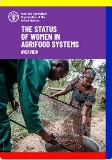Women’s equality in agrifood systems could boost the global economy by $1 trillion, reduce food insecurity by 45 million: new FAO report

Women engaged in wage employment in agriculture earn 82 cents for every dollar that men earn.
The status of women in agrifood systems report, the first of its kind since 2010, goes beyond agriculture to provide a comprehensive picture of the status of women working across agrifood systems— from production to distribution and consumption.
The report highlights that globally, 36 per cent of working women are employed in agrifood systems, along with 38 per cent of working men. However, women’s roles tend to be marginalized and their working conditions are likely to be worse than men’s –irregular, informal, part-time, low-skilled, or labour-intensive. Likewise, women engaged in wage employment in agriculture earn 82 cents for every dollar that men earn.
Women also have less secure tenure over land, less access to credit and training, and have to work with technology designed for men. Along with discrimination, these inequalities create a 24 per cent gender gap in productivity between women and men farmers on farms of equal size.
Notably, the study underscores that agrifood systems are a more important source of livelihood for women than for men in many countries. For instance, in sub-Saharan Africa 66 per cent of women’s employment is in the sector, compared with 60 per cent of men. In southern Asia, women overwhelmingly work in agrifood systems (71 per cent of women, versus 47 per cent of men), although fewer women than men are in the labour force.

